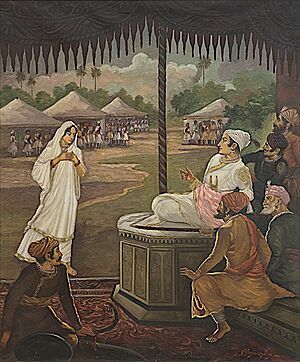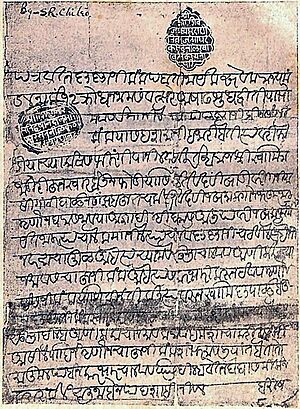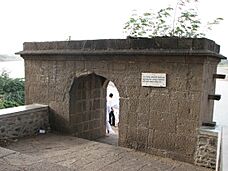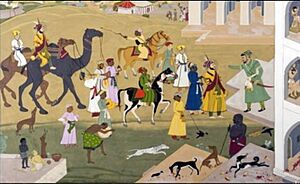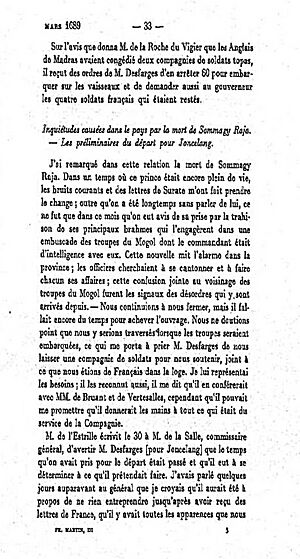Sambhaji facts for kids
Quick facts for kids Sambhaji |
|
|---|---|

A painting of Sambhaji, late 17th century
|
|
| 2nd Chhatrapati of the Marathas | |
| Reign | 16 January 1681 – 11 March 1689 |
| Coronation | 20 July 1680, Panhala (symbolic) or 16 January 1681, Raigad fort (official) |
| Predecessor | Shivaji I |
| Successor | Rajaram I |
| Peshwa |
|
| Born | 14 May 1657 Purandar Fort, Ahmadnagar Subah, Mughal Empire (present-day Pune District, Maharashtra, India) |
| Died | 11 March 1689 (aged 31) Tulapur, Ahmadnagar Subah, Mughal Empire |
| Cause of death | Execution |
| Spouse | Yesubai |
| Issue | Bhavani Bai Shahu I |
| House | Bhonsle |
| Father | Shivaji I |
| Mother | Saibai |
| Religion | Hinduism |
Sambhaji (born around May 14, 1657 – died March 11, 1689), also known as Shambhuraje, was the second Chhatrapati (meaning "chief or head of the Kshatriyas," a royal title) of the Maratha Empire. He ruled from 1681 to 1689. Sambhaji was the eldest son of Shivaji, who founded the Maratha Kingdom. His time as ruler was mostly spent fighting wars. He fought against the powerful Mughal Empire and other nearby groups. These included the Abyssinians of Janjira, the Wadiyars of Mysore, and the Portuguese Empire in Goa. After Sambhaji's death, his brother Rajaram I became the next Chhatrapati. Rajaram continued the long wars against the Mughals.
Contents
Early Life and Childhood
Sambhaji was born at Purandar fort. His father was the Maratha Emperor Shivaji, and his mother was Saibai. Sadly, his mother died when he was only two years old. After her death, his grandmother, Jijabai, raised him.
When Sambhaji was nine, he was sent to live with Raja Jai Singh I of Amber. This was part of a deal called the Treaty of Purandar. Shivaji had signed this treaty with the Mughals in 1665. Sambhaji went as a political hostage. This meant he stayed with the Mughals to ensure Shivaji kept his promises. Because of this treaty, Sambhaji also became a Mughal mansabdar. This was a military rank and land grant in the Mughal system.
Sambhaji and his father Shivaji visited the Mughal emperor Aurangzeb's court in Agra in 1666. Aurangzeb put them under house arrest, but they managed to escape in July 1666. Later, the Marathas and Mughals became friendly again for a few years. During this time, Aurangzeb recognized Shivaji's title of Raja. Sambhaji was also given back his Mughal rank. Shivaji then sent Sambhaji to serve under Prince Mu'azzam, the Mughal viceroy. Sambhaji visited Prince Mu'azzam in Aurangabad in 1667. He was given rights to collect taxes in Berar. After a short stay, Sambhaji returned home. Maratha officers stayed behind. During this period, Marathas under Sambhaji even fought alongside the Mughals against the Sultanate of Bijapur.
Marriage and Family
Sambhaji married Jivubai. This marriage was a political alliance. According to Maratha custom, she took the name Yesubai. Jivubai's father was Pilaji Shirke. He had joined Shivaji's service earlier. This marriage helped Shivaji gain control of the Konkan coastal area. Yesubai and Sambhaji had two children. Their daughter was Bhavani Bai. Their son was Shahu I, who later became the Chhatrapati of the Maratha Empire.
Difficult Times and Escape
Sambhaji's behavior sometimes caused problems. Because of this, Shivaji put him in prison at Panhala fort in 1678. However, Sambhaji escaped from the fort with his wife. He then joined Diler Khan, a Mughal general, in December 1678. He stayed with the Mughals for about a year.
Sambhaji later learned that Diler Khan planned to arrest him and send him to Delhi. So, he returned home. Upon his return, Sambhaji was kept under watch at Panhala fort.
Becoming the Chhatrapati
When Shivaji died on April 5, 1680, Sambhaji was still held captive at Panhala fort. At that time, Soyrabai, Shivaji's wife and Sambhaji's stepmother, wanted her own son, Rajaram I, to become king. Rajaram was only ten years old. Soyrabai and some important ministers worked together against Sambhaji.
Sambhaji heard this news. He planned his escape and took control of Panhala fort on April 27. He did this by killing the fort commander. By June 18, he had also gained control of Raigad Fort, the capital. Sambhaji officially became the Chhatrapati on July 20, 1680. Rajaram, his wife, and his mother Soyrabai were put in prison. Later, some of Soyrabai's relatives and Shivaji's ministers were found to be plotting against Sambhaji again. They were punished for this conspiracy.
Military Campaigns and Conflicts
Soon after becoming king, Sambhaji started military campaigns against neighboring states. He attacked Burhanpur and gave shelter to Prince Akbar, Aurangzeb's son. This made Aurangzeb move his large Mughal army south.
Attack on Burhanpur
In 1680, Sambhaji's forces attacked and looted Burhanpur. This city was a major Mughal trading center. The Marathas defeated the Mughal soldiers there. They took many valuable items from the city and burned its ports. Sambhaji then moved into Baglana, avoiding the Mughal army.
Wars with the Mughal Empire
In 1681, Akbar, Aurangzeb's fourth son, left the Mughal court. He joined some Muslim rebels in the Deccan region. Aurangzeb then moved his court south to Aurangabad to take charge of the war. The rebels were defeated, and Akbar fled to Sambhaji for safety. Some of Sambhaji's ministers tried to use this chance to put Rajaram back on the throne. They wrote a letter to Akbar, promising to join him against Sambhaji. Akbar gave this letter to Sambhaji. Angered, Sambhaji punished these ministers for their betrayal.
Akbar stayed with Sambhaji for five years. He hoped Sambhaji would help him take the Mughal throne. But this did not happen. Eventually, Sambhaji helped Akbar escape to Persia. Aurangzeb, after coming to the Deccan, never returned to his northern capital.
Siege of Ramsej (1682)
In 1682, the Mughals tried to capture the Maratha fort of Ramsej. They tried for five months, using explosives and building wooden towers. But the Mughal siege failed.
Aurangzeb tried to attack the Maratha Empire from all sides. He wanted to use his large army to win. Sambhaji had prepared well for these attacks. Maratha forces fought the Mughals in many small battles. They used guerilla warfare tactics, which means surprise attacks and quick retreats. Sambhaji and his generals also attacked and defeated Mughal generals when they had a good chance. Sambhaji's plan was to keep his own losses low. If the Mughals were too strong, the Marathas would retreat. This plan worked very well. Aurangzeb's generals could not capture Maratha lands for three years.
Mughal Invasions of Konkan (1684)
Aurangzeb then tried to attack the Maratha capital, Raigad Fort, directly. He tried to surround it from both north and south. This led to the Mughal invasions of Konkan (1684). The Marathas defeated the Mughals badly. The difficult climate of the region also helped the Marathas. These failures made Aurangzeb focus on other kingdoms for a while. Under Sambhaji, the Marathas were active across western India.
Conflict with the Siddis of Janjira
The Marathas had long fought with the Siddis. The Siddis were Muslims of Abyssinian (African) descent who had settled in India. They fought over control of the Konkan coast. Shivaji had limited their power to the island fort of Janjira. Sambhaji continued the fight against them. The Siddis formed an alliance with the Mughals.
In early 1682, a Maratha army, later joined by Sambhaji himself, attacked Janjira. They attacked for thirty days, causing much damage. But they could not break through the fort's defenses. Sambhaji then tried a trick. He sent some of his people to the Siddis, pretending to be traitors. They were allowed into the fort. Their plan was to blow up the gunpowder magazine during a Maratha attack. However, one of the female "traitors" got involved with a Siddi man. He found out about the plot, and the infiltrators were executed.
The Marathas then tried to build a stone causeway (a raised road) from the shore to the island. But they were stopped halfway. The Mughal army moved to threaten Raigad. Sambhaji had to return to fight them. His remaining troops could not defeat the Janjira fort or the Siddi ships protecting it.
Battles with the Portuguese and English
After failing to take Janjira in 1682, Sambhaji sent a commander to capture the Portuguese fort of Anjadiva. The Marathas took the fort, hoping to make it a naval base. But in April 1682, 200 Portuguese soldiers drove them out. This event led to a bigger fight between the two powers.
The Portuguese colony of Goa helped the Mughals. They let the Mughals use their ports and travel through their land. To stop this help, Sambhaji attacked Portuguese Goa in late 1683. He stormed the colony and took its forts. The situation for the Portuguese became very bad. The Portuguese viceroy, Francisco de Távora, conde de Alvor, went to the cathedral. He prayed for help at the tomb of Saint Francis Xavier. He even opened the saint's casket and placed his royal items inside, asking for the saint's support. Sambhaji's Goa campaign ended when the Mughal army and navy arrived in January 1684. This forced him to retreat.
Meanwhile, in 1684, Sambhaji made a peace agreement with the English in Bombay. He needed English weapons and gunpowder. The Marathas lacked artillery and explosives, which made it hard to attack forts. With this new support, Sambhaji went on to capture Pratapgad and other forts along the Ghats.
Conflict with Mysore
Like his father Shivaji's campaign in Karnataka, Sambhaji tried to invade Mysore in 1681. Mysore was a southern kingdom ruled by Wodeyar Chikkadevaraja. Sambhaji's large army was pushed back, just as Shivaji's had been in 1675. Chikkadevraja later made agreements and paid tribute to the Maratha kingdom. This happened during the conflicts from 1682 to 1686. However, Chikkadevraja then started to become friendly with the Mughal Emperor. He stopped following his agreements with the Marathas. In response, Sambhaji invaded Mysore again in 1686. He was joined by his Brahmin friend and poet Kavi Kalash.
Capture and End of Reign
In the 1687 Battle of Wai, a key Maratha commander, Hambirrao Mohite, was killed. After this, many Maratha soldiers started to leave the army. In February 1689, Sambhaji and 25 of his advisors were captured. This happened during a small fight at Sangameshwar. Mughal forces led by Ganoji Shirke and Muqarrab Khan captured them. Officials close to Sambhaji had spied on him. They gave information about his location to Muqarrab Khan.
A French Governor of Pondicherry from that time, François Martin, wrote in his diary. He mentioned that "close Brahmins" were the ones who betrayed Sambhaji. Martin's diary says that these Brahmins betrayed Sambhaji Maharaj. This led to his capture by the Mughal army. After this, the whole of South India faced great confusion.
Stories about Sambhaji's meeting with the Mughal ruler and his death vary. But most agree that he was put to death on the emperor's orders.
How Sambhaji Ruled
Sambhaji took over the system of government that Shivaji had created. He continued most of his father's policies. Sambhaji managed the state with the help of his chief minister and a council of eight ministers. Historians say that Sambhaji was a good ruler. He gave fair justice to all his people.
Helping Farmers During Drought
The region of Maharashtra faced a severe drought during Sambhaji's rule (1684–1688). Sambhaji had to take many steps to deal with this difficult situation. He continued Shivaji's policies of helping poor farmers. Historians note that his approach to famine was very helpful. He found solutions to many complex problems. His policies for storing water, irrigation, and planning crop patterns showed his forward-thinking ideas.
During the drought, Sambhaji provided farmers with grain seeds. He also gave them tax breaks, oxen for farm work, and farming tools. All these measures were put into action carefully during the drought.
Encouraging Farming
Sambhaji strongly encouraged farming in the Maratha state. Farming was the most important part of the rural Maratha economy. He encouraged people to cultivate more and more land. Sambhaji's government promised safety to Marathas who had gained freedom from the Mughals. He asked them to return to their farming work in their lands. He also called back people who had run away because they could not pay taxes. He asked them to continue their farming work.
In a letter from June 3, 1684, Sambhaji told his Peshwa (chief minister) Nilkantha Moreshwar to make sure that government-owned farmland was cultivated. This land would otherwise have remained unused. He also asked for fifty khandis (a measure of grain) to be sent from Sagargad. This grain was to be given to the farmers.
Sambhaji tried to increase the income from farming activities. He also worked to cultivate more unused or barren lands.
Religious Policy
Sambhaji, his ministers, and officers were interested in supporting cultural and religious activities in the state. They honored and encouraged learning. They did this by giving land, grains, and money to scholars.
New Ideas and Innovations
Sambhaji used many new ideas during his military campaigns. One such idea was making leather jackets for his soldiers. This was to protect them from poisonous arrows used by the Mysore army. During his campaign against Mysore, the Maratha army first faced defeat due to these arrows. But after using the leather jackets, they were able to block the arrows and win the battle.
Literary Contributions
Sambhaji was a smart and educated ruler. He knew several languages besides Marathi. Keshav Pandit was hired to teach Sambhaji. Keshav Pandit was a very knowledgeable scholar. He knew a lot about law, Sanskrit language, and literature. He also seemed to know about different sciences and music from ancient scholars. Keshav Pandit wrote a book on Maratha law called Dandaniti. He also wrote a Sanskrit biography of Sambhaji's brother, Rajaram, called 'Shri Rajaramacharitra'. This book described Rajaram's early campaigns and his escape to Jinji.
Sambhaji himself wrote several books. The most famous is Budhbhushanam, written in both Marathi and Sanskrit. He also wrote three other books: Nayikabhed, Saatsatak, and Nakhshikha, which are in the Hindustani language. In Budhbhushanam, Sambhaji wrote poems about politics. He discussed what a king should and should not do, and talked about military strategies. The first few verses praise his grandfather Shahaji and his father Shivaji. In Budhbhushan, Sambhaji saw Shahaji as a form of the god Indra. He saw Shivaji as a form of the god Vishnu who saved the earth and brought back fairness.
Other scholars also wrote about Sambhaji. Kavindra Paramanand Govind Newaskar wrote Anupurana. This was a Sanskrit biography of Sambhaji's life up to the birth of Shahu I. Hari Kavi, also known as Bhanubhatta, wrote Haihayendra Charitra and its explanation, Shambu Vilasika, for Sambhaji. Hari Kavi also wrote Subhashitaharavalli and a Sanskrit biography called Shambhuraja Charitra about Sambhaji's life in 1684.
What Happened Next
Sambhaji's death caused great confusion in the Maratha Kingdom. His younger half-brother Rajaram I then became the king. Rajaram moved the Maratha capital far south to Jinji. Meanwhile, Maratha guerrilla fighters, led by Santaji Ghorpade and Dhanaji Jadhav, continued to trouble the Mughal army.
A few days after Sambhaji's death, the capital Raigad Fort fell to the Mughals. Sambhaji's wife, Yesubai, his son, Shahu, and Shivaji's wife, Sakvarbai, were captured. Sakvarbai died while held by the Mughals. Shahu was seven years old when he was captured. He remained a prisoner of the Mughals for 18 years, from 1689 until Mughal Emperor Aurangzeb's death in 1707.
Shahu was then set free by Emperor Muhammad Azam Shah, Aurangzeb's son. After his release, Shahu had to fight a short war to become king. His aunt Tarabai, Rajaram's widow, claimed the throne for her own son, Shivaji II. The Mughals kept Yesubai captive to make sure Shahu followed the terms of his release. She was released in 1719 when the Marathas became strong under Shahu and Peshwa Balaji Vishwanath.
Images for kids
See also
- Bhosale family ancestry
- Maratha clan system
- Marathi people


